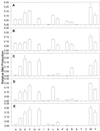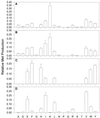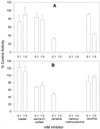Methionine regeneration and aspartate aminotransferase in parasitic protozoa
- PMID: 11443076
- PMCID: PMC95336
- DOI: 10.1128/JB.183.15.4421-4434.2001
Methionine regeneration and aspartate aminotransferase in parasitic protozoa
Abstract
Aspartate aminotransferases have been cloned and expressed from Crithidia fasciculata, Trypanosoma brucei brucei, Giardia intestinalis, and Plasmodium falciparum and have been found to play a role in the final step of methionine regeneration from methylthioadenosine. All five enzymes contain sequence motifs consistent with membership in the Ia subfamily of aminotransferases; the crithidial and giardial enzymes and one trypanosomal enzyme were identified as cytoplasmic aspartate aminotransferases, and the second trypanosomal enzyme was identified as a mitochondrial aspartate aminotransferase. The plasmodial enzyme contained unique sequence substitutions and appears to be highly divergent from the existing members of the Ia subfamily. In addition, the P. falciparum enzyme is the first aminotransferase found to lack the invariant residue G197 (P. K. Mehta, T. I. Hale, and P. Christen, Eur. J. Biochem. 214:549-561, 1993), a feature shared by sequences discovered in P. vivax and P. berghei. All five enzymes were able to catalyze aspartate-ketoglutarate, tyrosine-ketoglutarate, and amino acid-ketomethiobutyrate aminotransfer reactions. In the latter, glutamate, phenylalanine, tyrosine, tryptophan, and histidine were all found to be effective amino donors. The crithidial and trypanosomal cytosolic aminotransferases were also able to catalyze alanine-ketoglutarate and glutamine-ketoglutarate aminotransfer reactions and, in common with the giardial aminotransferase, were able to catalyze the leucine-ketomethiobutyrate aminotransfer reaction. In all cases, the kinetic constants were broadly similar, with the exception of that of the plasmodial enzyme, which catalyzed the transamination of ketomethiobutyrate significantly more slowly than aspartate-ketoglutarate aminotransfer. This result obtained with the recombinant P. falciparum aminotransferase parallels the results seen for total ketomethiobutyrate transamination in malarial homogenates; activity in the latter was much lower than that in homogenates from other organisms. Total ketomethiobutyrate transamination in Trichomonas vaginalis and G. intestinalis homogenates was extensive and involved lysine-ketomethiobutyrate enzyme activity in addition to the aspartate aminotransferase activity. The methionine production in these two species could be inhibited by the amino-oxy compounds canaline and carboxymethoxylamine. Canaline was also found to be an uncompetitive inhibitor of the plasmodial aspartate aminotransferase, with a K(i) of 27 microm.
Figures







Similar articles
-
Methionine regeneration and aminotransferases in Bacillus subtilis, Bacillus cereus, and Bacillus anthracis.J Bacteriol. 2003 Apr;185(8):2418-31. doi: 10.1128/JB.185.8.2418-2431.2003. J Bacteriol. 2003. PMID: 12670965 Free PMC article.
-
Methionine formation from alpha-ketomethiobutyrate in the trypanosomatid Crithidia fasciculata.FEMS Microbiol Lett. 1998 Aug 15;165(2):305-12. doi: 10.1111/j.1574-6968.1998.tb13162.x. FEMS Microbiol Lett. 1998. PMID: 9742703
-
Tyrosine aminotransferase catalyzes the final step of methionine recycling in Klebsiella pneumoniae.J Bacteriol. 1999 Mar;181(6):1739-47. doi: 10.1128/JB.181.6.1739-1747.1999. J Bacteriol. 1999. PMID: 10074065 Free PMC article.
-
Aspartate aminotransferase: bridging carbohydrate and energy metabolism in Plasmodium falciparum.Curr Drug Metab. 2012 Mar;13(3):332-6. doi: 10.2174/138920012799320400. Curr Drug Metab. 2012. PMID: 22455555 Review.
-
Evolutionary and biosynthetic aspects of aspartate aminotransferase isoenzymes and other aminotransferases.Ann N Y Acad Sci. 1990;585:331-8. doi: 10.1111/j.1749-6632.1990.tb28065.x. Ann N Y Acad Sci. 1990. PMID: 2192617 Review.
Cited by
-
An immunoproteomic approach to identifying immunoreactive proteins in Leishmania infantum amastigotes using sera of dogs infected with canine visceral leishmaniasis.Pathog Glob Health. 2019 May;113(3):124-132. doi: 10.1080/20477724.2019.1616952. Epub 2019 May 17. Pathog Glob Health. 2019. PMID: 31099725 Free PMC article.
-
Plasmodium falciparum glutamate dehydrogenase a is dispensable and not a drug target during erythrocytic development.Malar J. 2011 Jul 14;10:193. doi: 10.1186/1475-2875-10-193. Malar J. 2011. PMID: 21756354 Free PMC article.
-
Effects of glutamate oxaloacetate transaminase on reactive oxygen species in Ganoderma lucidum.Appl Microbiol Biotechnol. 2023 Mar;107(5-6):1845-1861. doi: 10.1007/s00253-023-12417-3. Epub 2023 Feb 9. Appl Microbiol Biotechnol. 2023. PMID: 36754884
-
Branched-chain aminotransferase4 is part of the chain elongation pathway in the biosynthesis of methionine-derived glucosinolates in Arabidopsis.Plant Cell. 2006 Oct;18(10):2664-79. doi: 10.1105/tpc.105.039339. Epub 2006 Oct 20. Plant Cell. 2006. PMID: 17056707 Free PMC article.
-
Trypanosoma brucei metabolite indolepyruvate decreases HIF-1α and glycolysis in macrophages as a mechanism of innate immune evasion.Proc Natl Acad Sci U S A. 2016 Nov 29;113(48):E7778-E7787. doi: 10.1073/pnas.1608221113. Epub 2016 Nov 15. Proc Natl Acad Sci U S A. 2016. PMID: 27856732 Free PMC article.
References
-
- Ayala F J, Escalante A A, Lal A A, Rich S M. Evolutionary relationships of human malaria parasites. In: Sherman I, editor. Malaria: parasite biology, pathogenesis, and protection. Washington, D.C.: ASM Press; 1998. pp. 285–300.
-
- Backlund P S, Chang C P, Smith R A. Identification of 2-keto-4-methylthiobutyrate as an intermediate compound in methionine synthesis from 5′-methylthioadenosine. J Biol Chem. 1982;257:4196–4202. - PubMed
-
- Backlund P S, Smith R A. Methionine synthesis from 5′-methylthioadenosine in rat liver. J Biol Chem. 1980;256:1533–1535. - PubMed
Publication types
MeSH terms
Substances
Associated data
- Actions
- Actions
- Actions
- Actions
Grants and funding
LinkOut - more resources
Full Text Sources
Molecular Biology Databases

